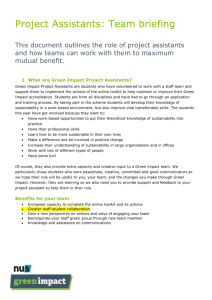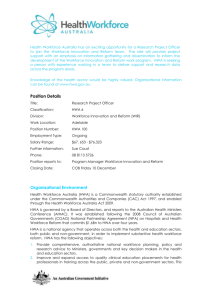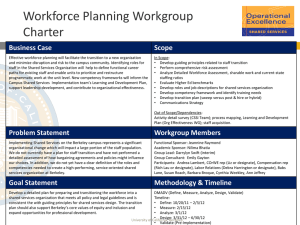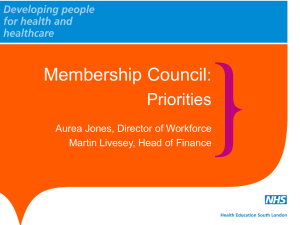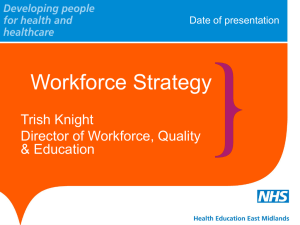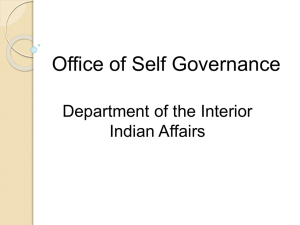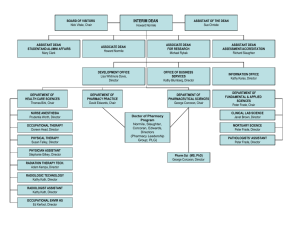View the presentation slides here
advertisement
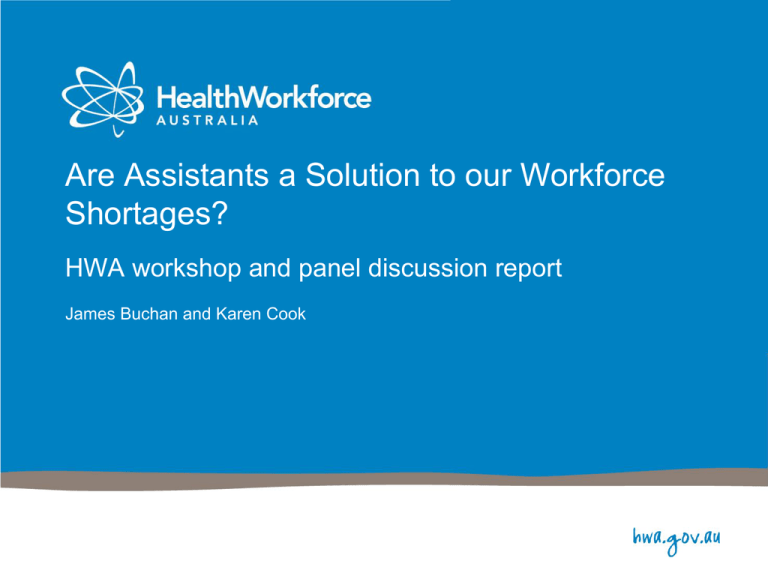
Are Assistants a Solution to our Workforce Shortages? HWA workshop and panel discussion report James Buchan and Karen Cook Background • There is significant evidence that assistants are a key part of the workforce. • Some areas are using them more extensively and effectively than others. • HWA is currently doing some work on assistant and support roles. 2 Session aims • Share current initiatives and perspectives on assistants and the support workforce. • Draw out key issues, identify areas of commonality, outline areas of difference and cover what’s next for this workforce. • Act as a consultation input for HWA’s work on Assistants and Support roles. 3 Our expert panel • Ms Deborah Law - Policy and Strategy Manager, HWA . • Ms Ann- Maree Keenan - Executive Director, Ambulatory and Nursing Services, Austin Health, Victoria • Dr Saravana Kumar - Deputy Director, International Centre for Allied Health Evidence, University of South Australia • Mr Andrew Larpent - CEO, Southern Cross Care • Mr Rod Cooke - CEO, Community Services and Health Industry Skills Council • Ms Lee Thomas - Federal Secretary, Australian Nursing and Midwifery Federation • Ms Tanya Lehmann - Principal Consultant Allied Health, Country Health SA Local Health Network 4 Deborah Law, HWA • Setting the scene; outlining HWA related work on assistants/other work • Always a core part of the broader health/care workforce.. • But only one facet in pursuit of availability/ sustainability/ affordability • Multiplicity of roles, titles, uses, training…deflected from national attention/debate from most productive models 5 Deborah Law HWA • Four main aspects: 1.Roles they undertake 2.Contributions they make 3.The way they work (substitution/ supplementation/ workforce of choice) to enable everyone to work to full scope 4.Not an “unqualified” workforce (partic.aged care) • = Active management of perceived and real barriers • National guidance/ local governance 6 Ann Maree Keenan, Austin • 900 bed tertiary hospital, 8000 staff • Recognised need to use workforce to best capacity • 2008-9 feasibilty study- asked nurses what would make work easier/ more rewarding • Assistant introduced- Complementary role • Outcomes-incl. +staff satisfaction; pathway to other health careers 7 Ann Maree Keenan • • • • Governance at organisational level Leadership from nursing team Communication Education- grow your own- clear selection process • Role clarity- delegation, supervision • Nurses satisfaction- basic care now being attended to/ not managed previously 8 Saravana Kumar • Allied Health Assistants • Increasingly recognised as an important piece of the puzzle, but not always well integrated • Benefits: +patient satisfaction;+ access; AHPs working to full scope • Barriers; poor clarity about delegation + supervision; role delineation ;turf protection • ..little evidence of cost effectiveness, or how AHP’s can be used when released 9 Saravana Kumar • Why, despite the evidence are there ongoing challenges in integration of roles?: • Change management issues • AHA roles, work settings, delegation and supervision, skills of AHP in delegation and supervision; role divisions 10 Andrew Larpent • ?? Use of title of “assistants”? • Need right type of worker for care requirementsmatching • Silos between health/ aged care • Some existing health professionals felt threatened by the HWA , ACWR project • Focused on the caring profession as the key deliverer, not med/tech • Referred to UK NHS Francis report 11 Andrew Larpent • New models of care/ new roles- e.g PCA in community dementia care • New worker- STELLA- Specially Trained End of Life Living Assistant 12 Rod Cooke • Large component of an even larger workforce, where 69% are informal carers • Also questioned use of title “assistant” • Different roles and titles • Lack of other workers in some care environments to provide supervision 13 Rod Cooke • Demographic, funding and policy drivers to increased use of assistants • E.g +125,000 needed in disability care in next few years • Need for increased training and development capacity • ..a “partial answer” to shortages 14 Lee Thomas • Current growing and essential part of the nursing family • Lack of national consistency [e.g compared to plumbers, electricians] • Changing nature of hospital based care- i.e. Increased acuity- yet no nationally mandated quals for AINs in acute care • Huge variations in qualifications, titles, education 15 Lee Thomas • Apply a single title to the role • National regulation “the best way”- incl prof practice framework and defined scope of practice • Emphasis on minimum level of knowledge; protection of the public • “Everyone is responsible” 16 Tanya Lehmann • Focus on rural/remote- health disparities; geog. distribution issues • Small dispersed population; lower frequency of need; smaller quantity of service- different workforce models required • (Local) assistants are needed in remote communities- more generalists • Issues of training, supervision and governance; telehealth 17 Tanya Lehmann • Assistants as a solution: • Small numbers= “little change can make a big difference”; +job satis, patient satis, productivity • Remote supervision can work; need to have role clarity; distinguish between delegated and assigned tasks; • Need to variation- one size does not fit all=cant overstandardise/ nationalise • Risk management not regulation • Focus for safety, quality 18 The questions • What might need to be done in order to better utilise assistant and support roles in the workforce? • What risks would need to be managed? 19 The themes • • • • • Safety and quality The contribution that assistants can make Career development Organisational readiness Industry and regulatory considerations 20 The results – Safety and Quality • Appropriate competency based training • Clearly defined roles and scope of practice, including supervision, so the roles and parameters are understood • Clear rationale for implementing the role • Focusing on growing your own and making sure it is context specific for the community • Need for regulation 21 The results – The Contribution that Assistants can make • Increased understanding of the role in health care teams and the community • Establishing a national framework which matches the role against the education • Articulation of a clear career pathway with early exposure to assistant roles as a career option at school • Need to establish the evidence for safe integration and establishing the benchmark for the ratio between skilled and unskilled workers 22 The results – Career Development • Training and education needs to be based on agreed core competencies which can be built on for different career paths • Existing workforce is able to supervise and mentor assistants effectively • Importance of describing the scope of the assistant and the mapping of core competencies, leading to specialisation of some kind, (eg speech, OT, dental) or across professions and service delivery areas • Professionals need to be trained to supervise and delegate 23 The results – Organisational Readiness • Reform process has to be done together ie workforce, clinical and education reform • Focus of a good delegation supervision framework rather than rigid scope of practice • Upfront identification of patient need • Broad communication about the changes needed /management 24 The results – Industrial and regulatory considerations • • • • • Clarity between industries – one size may not fit all Generalist not specialist National minimum training competency standards Clear framework for risk management (indemnity etc) Funding for upskilling 25 (Some) Identified Risks and Barriers • How to evaluate the costs and effectiveness of the role? • Acceptance/ resistance from established professionals/ supportive work environment? • Public awareness / support • Cost saving as major perceived driver 26 (Some) Identified Risks and Barriers • Achieving serious buy in and engagement by management • Government appetite for change? • Overregulation-management response?/assistant, potential assistant response? 27 In summary.. • Assistants are a key component in the overall solution • National guidance/local governance • Active management of real and perceived barriers • Regulation issue remains unresolved 28 In summary • Assistants are a key component in the overall solution • On oredr to be most eferive, there needs to be a level of national standardisation combined with local combined with l 29

